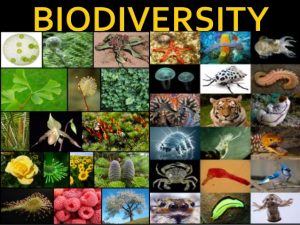
Biodiversity is defined as the variability among living organisms from all sources including, inter alia, terrestrial, marine and other aquatic ecosystems and the ecological complexes of which they are a part; this includes diversity within species, between species, and of ecosystems. Basically biodiversity is the total number of genes, species and ecosystems of a region. It includes (i) genetic diversity, (ii) species diversity and (iii) ecosystem diversity. Plants and animals constitute only a small component of biodiversity.
A biodiversity hotspot is a region with a high level of endemic species. Endemic species are those species that are found in a certain limited area. Two of the twelve biodiversity hotspots in the world are in India. They are the North-Eastern region and the Western Ghats.
Convention on Biodiversity
- Opened for signature at the Earth Summit in 1992 and entered into force on December 29, 1993
- There are 193 parties. Its secretariat is based in Montreal, Canada.
- US has signed but not ratified the treaty.
- It is an internationallegally-binding treaty with three main goals:
- conservationof biodiversity
- sustainable useof biodiversity
- fair and equitable sharingof the benefits arising from the use of genetic resources
- Its overall objective is to encourage actions which will lead to sustainable future
- CBD covers biodiversityat all levels: ecosystems, species and genetic resources
- It also covers biotechnology through theCartagena Protocol on Biosafety
- Its governing body is the Conference of Parties (COP). They meet every two years
- TheEcosystem Approach, an integrated strategy for the management of resources, is the framework for action under the Convention
- Precautionary principle: it states that where there is threat of significant reduction or loss of biological diversity, lack of full scientific certainty should not be used as a reason for postponing measures to avoid or minimize such threat.
- 2010 is the International Year of Biodiversity.
COP-10 of CBD
- Held at Nagoya, Japan in October 2010.
- It achieved three inter-linked goals
- Adoption of a new ten year strategic plan to save biodiversity
- Resource mobilization strategy to increase official development assistance for biodiversity
- A new international protocol on access to and sharing the benefits from the use of the genetic resources of the planet (Nagoya Protocol)
- Japan Biodiversity Fund was established
- COP-11 will take place in 2012 in India
Nagoya Protocol
- Nagoya Protocol on Access to Genetic Resources and the Fair and Equitable Sharing of Benefits Arising from Their Utilization
- The protocol creates a framework that balances access to genetic resources on the basis ofprior informed consent and mutually agreed terms with a fair and equitable sharing
- Expected to enter into force in 2012
- The Strategic Plan of CBD, which aims to arrest biodiversity loss throughout the world by 2020, will be called the Aichi Target. <Aichi is the prefecture in which Nagoya is situated>
Aichi Target
- The Strategic Plan of the CBD or the ‘Aichi Target’ adopted by the meeting include 20 headline targets, organised under five strategic goals that address the underlying causes of biodiversity loss, reduce the pressures on biodiversity, safeguard biodiversity at all levels, enhance the benefits provided by biodiversity, and provide for capacity building.
- The Aichi target will be the overarching framework on biodiversity not only for the biodiversity-related conventions, but for the entire UN system.
- Some targets
- 17 pc inland and 10 pc marine ecosystem
- Conserving coral reefs
- Restore 15 pc of degraded areas
- Halve or bring to zero the rate of loss of natural habitats including forests
- Target is that by 2020, at least 17 pc of terrestrial and inland water, and 10 pc of coastal and marine areas, especially areas of particular importance for biodiversity and ecosystem are conserved
- The conservation is to be done through effectively and equitably managed, ecologically representative and well connected systemsof protected areas and other effective area-based conservation measures, and integrated into the wider landscapes and seascapes.
